11 сентября 2001, стр. 48
Another point to consider, is that if the walls alone handle lateral loading, then the pressure on the windward wall must be transmitted via the corners to the remaining walls (this transmission of loading to the other walls is what gave the WTC its rigidity) but corners are far too weak to handle this task alone.
Although the «truss theory» is ludicrous, it has been pushed by many «experts». It should be noted that it is inconceivable that these experts did not know that it was false.
Where is the steel?
Since the trusses are incapable of resisting the wind loading, we know that the «official» explanation of the WTC collapse is false. If the floor joists (supports) were not the claimed trusses, then what were they? They had to be strong enough to support the floor slab and stiff enough to resist the wind loading. In fact, they had to be large steel beams. This is not to say that trusses were not used at all in the construction, but just that (contrary to the «official» line) the main floor joists were steel beams and not trusses.
The above argument using wind loading is certainly enough to tell one that trusses were not really used as the floor joists, but there are also other ways to determine this. Another approach is adopted in this section. We will:
• Calculate the weight of steel theoretically used in the construction of one of the towers assuming that the floor joists were trusses.
• Compare the result of this calculation to the 96,000 tons of steel known to have been used in the construction of each of the towers.
• Note that the calculated weight of steel is only 67 percent of the required 96,000 tons.
• Conclude that the 32,000 tons of steel unaccounted for, is due to the fact the the floor joists were actually weighty steel beams and not flimsy trusses (and thus that the official story is a lie spun to explain away what were obviously demolitions).
• Calculate a rough cross-sectional area for the steel beams that did serve as floor joists.
Since a cubic foot of steel weights 490 pounds, it is enough to deal with volumes rather than weights. We will calculate the volume of steel on a per floor basis.
To calculate the per floor volume of steel used in the construction of the twin towers, we will divide the calculation into three parts, namely, the volume of steel in the perimeter wall, the volume in the central core and the volume used in the floor support system.
The perimeter wall was comprised of box columns welded to large spandrel plates. Two typical prefabricated sections are illustrated below. Each consists of three spandrel plates welded to three box columns and each is three floors high.
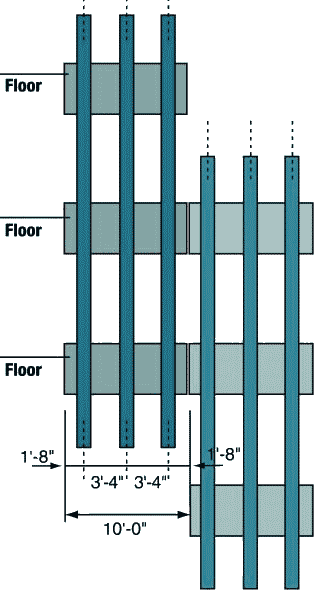
The first figure below shows the cross section of one of the perimeter box columns and its surrounds. The second and third figures detail the dimensions of two actual perimeter columns that were salvaged from the rubble.
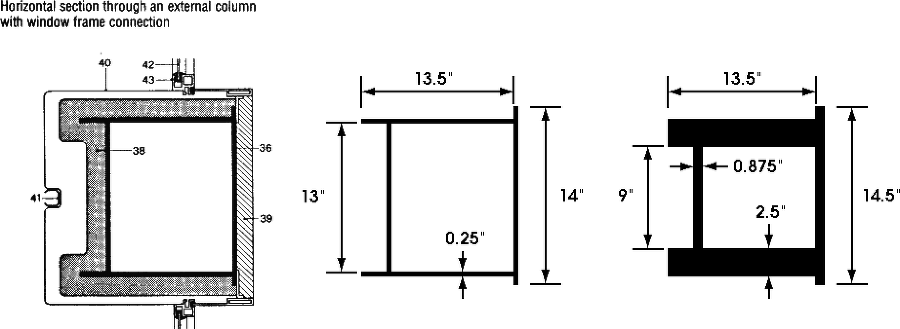
The numbers in the figure denote:
• 36 — the steel column
• 38 and 39 — fire resistant plaster
• 40 — aluminum facade
• 42 — window glass
• 43 — the window frame.
To obtain an estimate of the «typical» perimeter column, the dimensions of the perimeter columns listed in the WTC Steel Data Collection documentation were averaged. Whether this accurately reflects the true distribution of perimeter column thickness, is unclear, but it is all one has to go on (till those who hold the architectural details release them).
So, our «average» perimeter column has dimensions:
d = 13.4, t_w = 0.48, b_f = 12.9, t_(tf) = 0.32 and t_(bf) = 0.32.
and cross-sectional area:
2 x (13.4 x 0.48) + (12.9 x 0.32) + (14 x 0.32) = 21.5 square inches,
The parameters d, t_w, b_f, t_(tf) and t_(bf) are as in the following diagram from Appendix D which is part of the report found at http://www.house.gov/science/hot/wtc/wtcreport.htm.
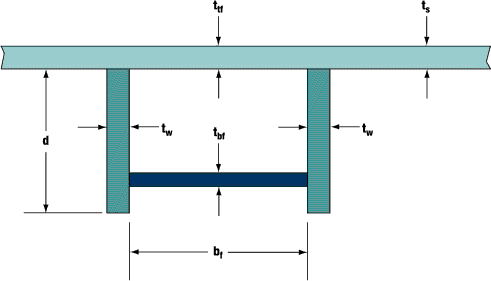
For the time being we will ignore the column end plates and the spandrel beams. Since each floor is 12 feet high, the per floor volume of steel in an average perimeter box column is:
12 x 21.5/144 = 1.792 cubic feet.
In total there are 240 such columns, so the volume of steel so far is
240 x 1.792 = 430 cubic feet.
Now lets deal with the volume of steel in the column end plates. Each end plate is 14 inches wide by 11.75 inches deep and 1.375 inches thick, giving a volume of
14 x 11.75 x 1.375 = 226.2 cubic inches = 226.2/1728 = 0.130896 cubic feet.
Since, on each floor, one third of the columns are joined, and each join involves two end plates, the per floor volume of steel in the end plates is
2 x 0.130896 x 240/3 = 20.9433 cubic feet.
The spandrel plates are large, being 52 inches high and 3/8 inches thick. Each floor has the equivalent of one spandrel beam that stretches 4 x 207 = 828 feet right around the building. The volume is easily calculated to be
828 x 12 x 52 x 3/8 = 193752 cubic inches = 193752/1728 = 112.125 cubic feet.
So the overall per floor volume of steel in the perimeter wall is
430 + 21 + 112 = 563 cubic feet.
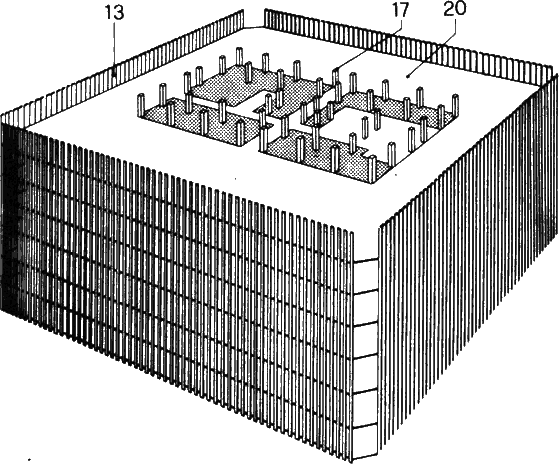
Now, we wish to calculate the per floor volume of steel in the core section of the building. To do this, we first need to calculate the volume of steel in each of the core columns. This is complicated by the fact that the dimensions of the columns reduced in size with increasing height. For example, at the base of the WTC some of these columns were 36 inches wide by 16 inches deep and 4 inches thick, whereas at the top, these box columns had transitioned to H-sections (I-sections) fabricated from 3/4 inch steel (the transition to H-sections occurred at floor 85). We will ignore the reduction in width and breadth of the columns, and only take into account the reduction in column thickness by assuming an average thickness of 2 inches (this roughly corresponds to a reduction in thickness of one quarter of an inch, every seven floors, up to floor 85). In reality, the column width and breadth decreased quite considerably and we only make this very generous assumption as the actual reductions in the width and breadth are unknown. So, we assume each core column has the following cross-section:
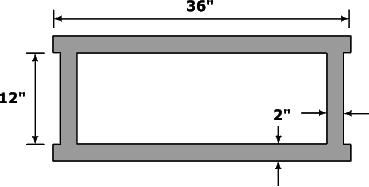
The cross-sectional area is (36 + 12 + 36 + 12) x 2 = 192 square inches = 192/144 = 1.333 square feet. Since each floor is 12 foot high, the per floor volume of steel in one such column is 12 x 1.333 = 16 cubic feet. Reports as to the number of core columns vary from 44 to 47. Once again, we will be generous in our assumptions and choose the higher figure of 47. Thus, the total volume of steel (per floor) in the core columns is
